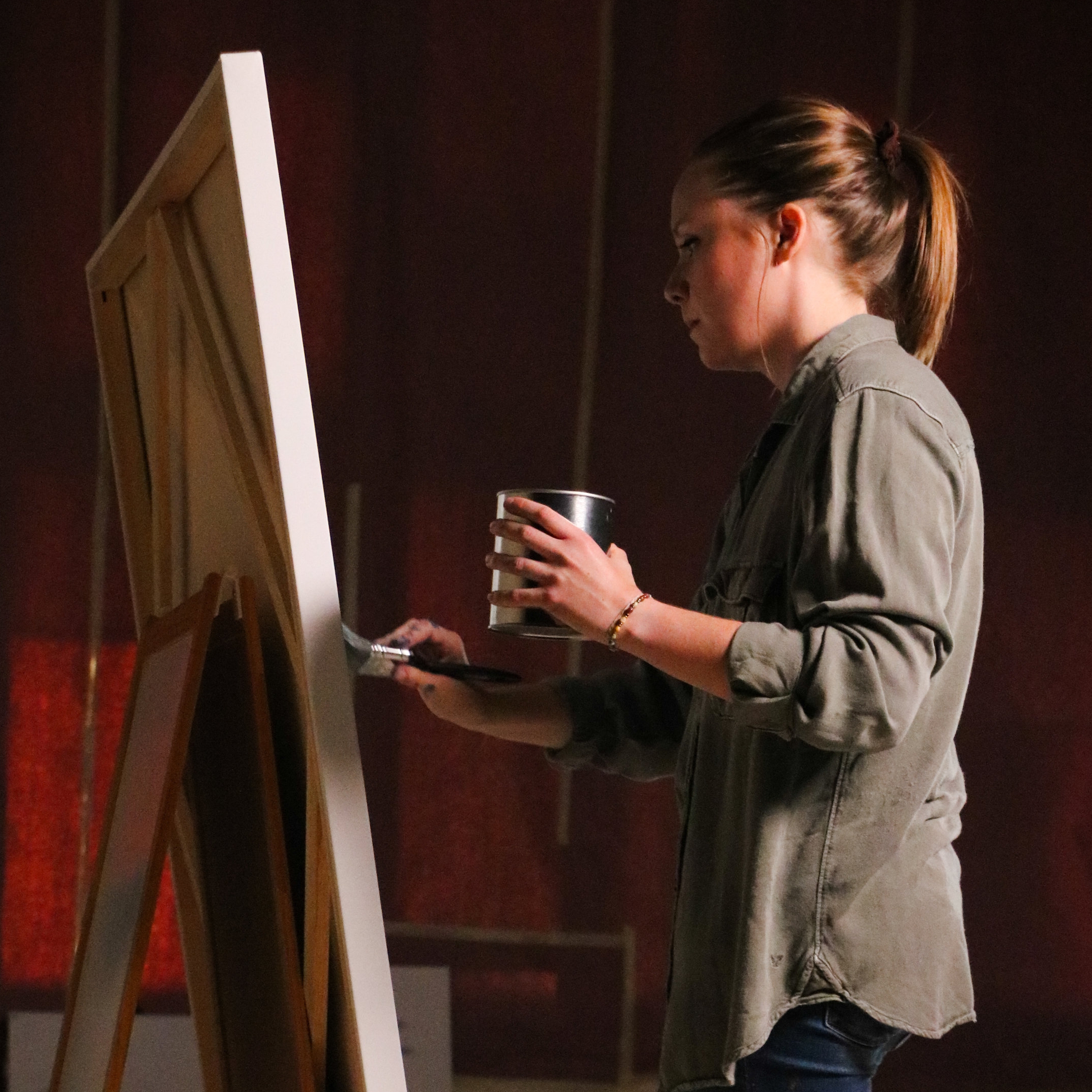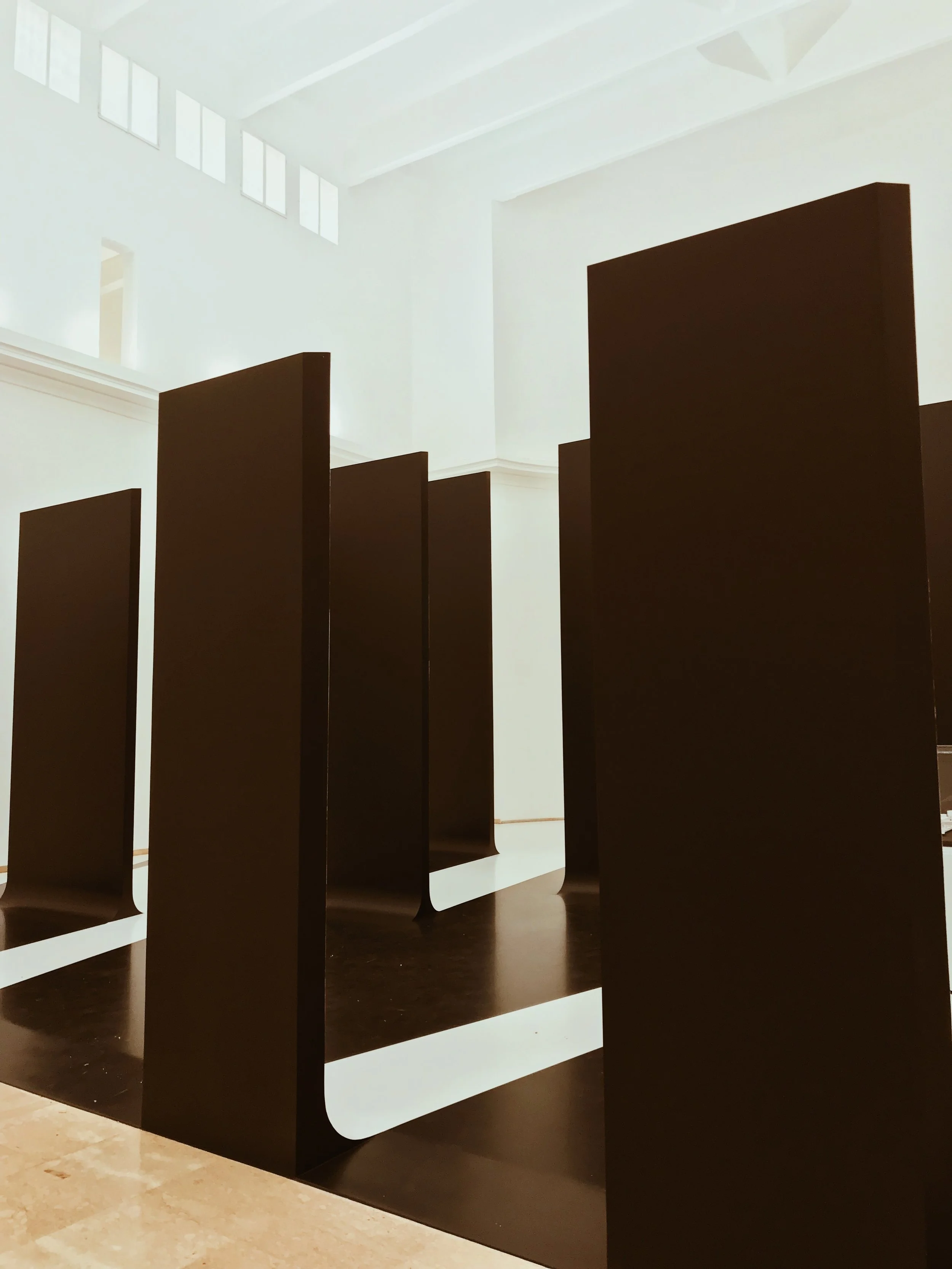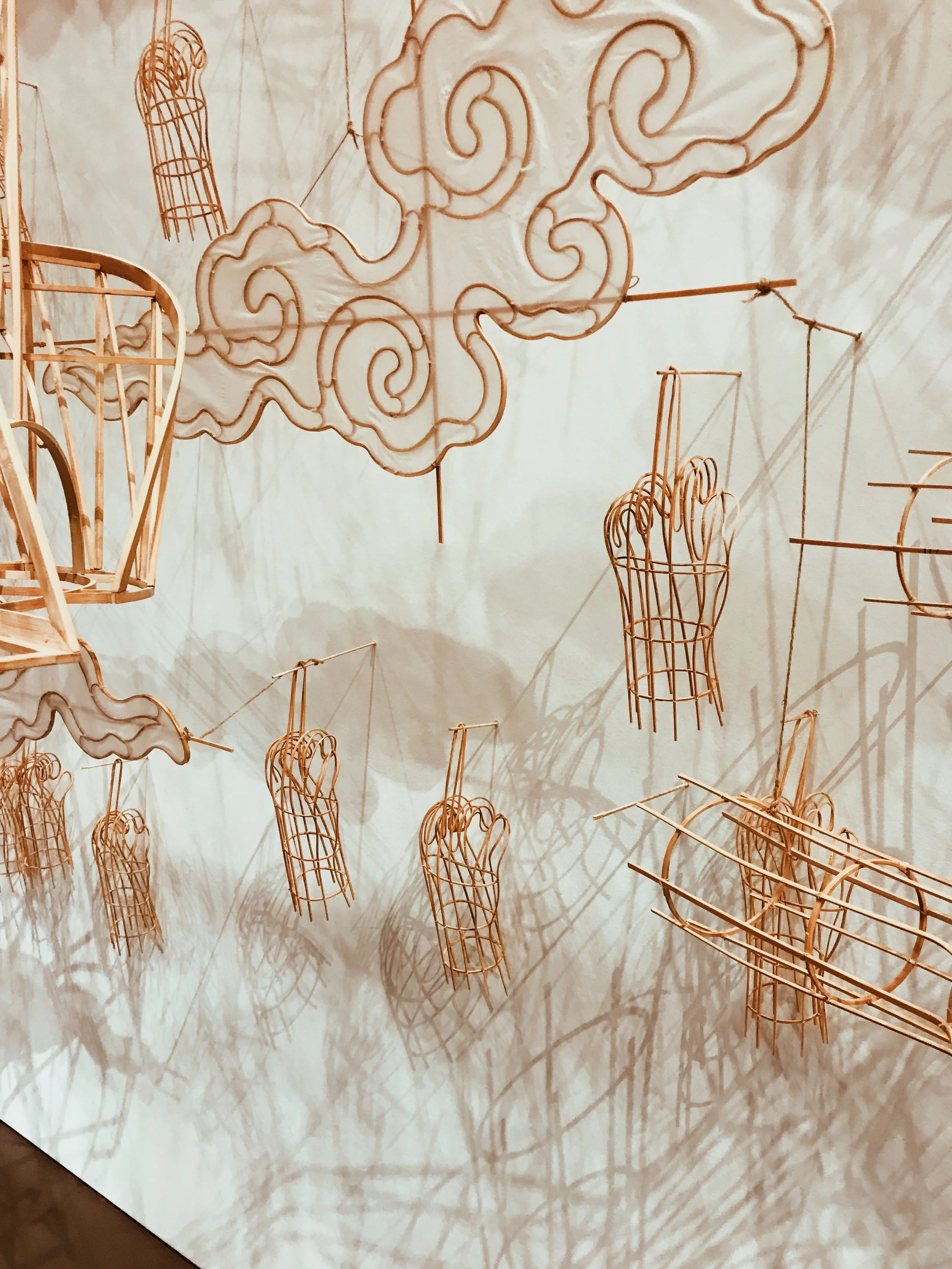Unbuilding Here - The Walls
This is an excerpt from a paper I wrote last year about walls and their lasting impact in the world. I proposed art as a means for healing once painful divides. In the process of researching, I discovered an exhibit occurring at the Venice 2018 Architecture Biennale called UNBUILDING WALLS commenting on the Berlin Wall, current walls, and the necessity for us to recognize our shared humanity.
So, I bought a ticket and went to Venice, Italy to see it. I was captivated by narratives told through tall black pieces of a wall reflecting Berlin, video testimonies of people living with walls around the world, and a glimpse of what it would feel like to be confined to a space being of a characteristic I was simply born with. GRAFTLab, the architecture firm creating the Venice installation, offered a travel grant to continue this narrative. I won. My project, UNBUILDING HERE, will explore these narratives across the US.
I simply leave this here as something to contemplate how walls influence identity, and art as a balm to pain and strife.
There are historical divides between groups, long lasting distinguishers between us and them spilling into the way policy, stigmas, and walls are formed. Sometimes these walls are mental constructions, but often they are accompanied by a physical border stating where we protect against the “other.” Borders and walls establish a narrative of divide and exclusion. Memories on either side of a border are often vastly different as the experiences of the wall as a blessing or curse illicit substantially different narratives.
In cases such as Berlin, for countless years a menacing wall represented physically and ideologically division. Then suddenly it was dismantled leaving behind East and West Berliners who for years had constructed different memories in relationship to the wall to integrate. Two identities of Berlin had been constructed and two identities had been dismantled. Reunification of East and West needed a unifying force between the two identities. Art can be used to address memories surrounding borders and establish a culture of inclusion and freedom in areas where walls once stood or still stand.
MEMORY
Memory is an important to understanding present narratives surrounding historical events. Narratives of the past, or the historical memory, are not static, but malleable. The way in which states, individuals, and groups remember the same event can be vastly different depending on their own policy and institutional goals. Elizabeth Jelin, in a discussion of memory and how it is used by actors, says that the “past acquires meaning in its intersection with the present” (Jelin 322). Previously unimportant events can suddenly become crucial to a nation’s history if mobilized to support new aims. Famous events can be cast in a darker light due to new discoveries or a desire to pivot away from iconic historical narratives.
Groups in society form identities based on these historical memories. Jan Assmann credits memory as being, “the faculty that enables us to form an awareness of selfhood (identity), both on the personal and on the collective level” (Assmann 109). So, disruption in the way historical events are understood is disruptive to identities. Meaningful engagement with difficult historical memories is necessary for a public to move forward, as this promotes peace. Cultural diplomacy projects using art would benefit peace building as it does not require a shared language or ideology, only a shared willingness to engage with art. This can open up space for reconciliation.
ART
Collectives institute a cohesive memory specifically through culture. Assmann breaks down Maurice Halbwachs understanding of memory and delineates between Halbwachs’ communicative memory and cultural memory. Communicative memory is not based on concrete things, while cultural memory uses, “External objects as carriers of memory” (Assmann 111). In interacting with objects, memories are formed and later trigger by the same object or any object that bears resemblance to the principal object. These external, cultural objects also preserve memories. For example, religious texts have contributed to the identity formation of cultures for centuries.
Because art functions as a cultural memory object, art can also be used in memory entrepreneurship. Interpretations of the past are depicted in art. Subsequently, art being made today interprets the present or sometimes reinterprets the past. Specific narratives of the present are pursued by artists, and if enough put forth the same interpretation, they are shaping how events are remembered. Jo-Anne Berelowitz says, “the artists is a social interventionist, a bi-national diplomat, a broker between communities and cultures…a visionary capable of transforming a space of restriction into one of radical openness” (Giudice 85).
“Ultimately, a physical wall used to securitize a border may not be permanent, but its impact on memories and identity last beyond physical demolition.”
WALLS
Historically, it seems to be a human instinct to build walls on borders. Iconic walls such as the Great Wall of China and the French Maginot Line were built to securitize borders. In present day, with information technology and the ease of movement of people and things across borders, walls occur often mentally dividing groups with no physical nearness.
Walls are constructed far beyond the physical manifestation and subsequent physical actions such as crossing a border. Janet Ward presents a comprehensive discussion on borders and identity formation, saying borders “can be best understood not just as a hegemonically linked set of containers, but rather as a series of re-defining, impermanent, and reciprocal engagements between structures and disintegration, stasis and movement, barrier and gateway” (Ward 7). Ultimately, a physical wall used to securitize a border may not be permanent, but its impact on memories and identity last beyond physical demolition.
Artists characteristically are viewed as free speakers and so the perfect actor to be memory entrepreneurs in border spaces. The artist can provide new memories and interpretations around a historical division, often in the actual space of a wall. Borders are spaces of interaction, where meanings are continuously performed through the bodies of those who cross them” (Giudice 82) and also those who create art around them.
BERLIN
The Berlin Wall stood from 1961-1989 impassible, immovable, indestructible, mirroring the fears of the international community on what communism could be. Winston Churchill described the wall as the, “Iron Curtain” dividing communist held East Berlin from the democratic West occupied by the United Stance, France, and Britain. Then, on November 9, 1989 faster than it was built the Wall came tumbling down. In 1990 East and West Berlin were reunified, dispelling beliefs of immovability.
But, the memories of divide still affected the perceptions of the international community on Germany and Berlin. Ward notes this, saying, “If World War II shaped Berlin’s division, then Berlin’s division shaped not just the city but the estranged double German identities” (Ward 4). Dismantling the Wall could not erase identities formed because of it, so art became the unifying force for Berliners as memory entrepreneurs forged a new narrative for Berlin, one of inclusion and freedom.
Art was first used in memory entrepreneurship while the Wall still stood. “For people whose lives unfolded at the Wall, there seemed little room for human agency” (Ward 65), until Thierry Noir painted his first mural on the wall. Noir lived in West Berlin in an apartment right next to the Wall. Daily, he looked upon the grey mass, called “dark subject matter” by Jonathan Jones in his article, “Thierry Noir: The First Graffiti Artist Fired Up by the Berlin Wall.” Noir painted bright cartoon murals on this cold surface.
Noir’s art was almost completely opposite of the type of art Hitler had institutionalized, social realism. In this way, art was used as memory entrepreneurship, providing an alternate interpretation of what was accepted in Berlin. This continued in 1987 with the 750th anniversary of Berlin, bringing with it, “A handful of residents, activist, artists, and government officials were also beginning to steer away from socialist realism as the predominant aesthetic” (Jordan 42) even while the wall stood. Art was continuously used to shape the identity of Berlin.
One example of how Berlin has used art as a mechanism for memory entrepreneurship on the international scale is artist Ryan Mendoza’s exhibit of Rosa Park’s house in his Berlin front yard. Rosa Parks is most well-known for opposing racial segregation in the United States by refusing to release her bus seat to a white man in Alabama in 1955. Mendoza created an art installation with Rosa Parks’ house in his Berlin neighborhood of Wedding because American institutions would not save the object of cultural and historical memory from destruction.
With the approval of Parks’ niece who owned the house in 2016, Mendoza dismantled it, transported it to Berlin in two containers, and rebuilt it. After removing trash, replacing windows, and hanging curtains, Mendoza installed a sound system playing interviews of Parks. Due to the stress of the overseas journey, the front door remained closed while the sound echoed out. Many people came to visit the house, including the Vice-Chancellor of Germany. Mendoza drew international attention to Berlin’s artists by making Berlin a home for a rejected American cultural artifact. In this way, Mendoza countered memories of Berlin exclusionary. He literally crossed the border of the US to leave in order to expand a civil rights narrative.
Berlin, a place historically associated with divide and being “us and them” has produced art and artists employing memory entrepreneurship for discourses of inclusion. “The Wall can be best understood as a highly intangible entity that is outlasting its physical manifestation in unforeseen ways” (Ward 8) like the extreme measures of a Berlin artist to develop an inclusionary space for a house associated with a woman who opposed racial divides. Art was and is a tool for memory entrepreneurship in the city of Berlin, presenting a new narrative for people to form identities around.
MEXICO
The division between the United States and Mexico has been contentious throughout almost the last two centuries. Ricardo Castro-Salazar provides a helpful understanding of the history of the relationship between the United States, Mexico, and the border in his article, “Navigating Historical Borders: Internal Colonialism and the Politics of Memory.”
The US-Mexico War of 1847-48 was a culmination of territory disputes between the two entities, escalating to an armed conflict after the US took the Republic of Texas. This war was opposed by Henry David Thoreau in his writing of Civil Disobedience, an early example of culture being used to promote an alternative historical narrative of an event. The US dominated Mexico as, “Texas and the disputed territory were incorporated into the Union with the rest of the lands taken from Mexico” (Castro-Salazar 41). This incorporation of Mexican land led to the assimilating of Mexican culture to American culture. Mexican Americans were viewed as lesser citizens, a populace at the disposal of America for laborious jobs.
Due to the border between the US and Mexico shifting upon the US acquiring land, Mexican American’s identity was confused. The land they never left was suddenly no long the Republic of Texas but part of the Union. Therefore, they were unwelcome and cast as “other” solely because of colonialism. Mexican absorption into America not as their ancestors emigrating, “from a distant country to a new promising land, as the US Pilgrims did, but that a new, dominant nation came to them and transformed them into second-class citizens” (Castro-Salazar 44).
Mexican Americans never crossed “into” any America themselves. The space of the US-Mexico border has continued to be a tool for the US to wield power over Mexico. Unlike Berlin where the Wall fell and a unified identity needed to be created, the border wall is instead continuously being fortified. This persistent view of all Mexican Americans being “illegal” and unwelcome status makes memory entrepreneurship difficult as America remains in an imposing, hegemonic position.
“ American art institutions became spaces of inclusion for art from the other side of the border, making a special effort to highlight Mexican artists.”
New memories can be created in contentious spaces and artists are an effective actor to do this because, “artists are able to contest dominant representations and hegemonic discourse” (Giudice 80) due to the nature of artists as epitomizing the freedom of expression. Artists have become memory entrepreneurs of what border space currently means and what it could be in the future.
Expression at the border can be seen in the inSITE exhibition starting in 1992. With projects in both Mexico and the United States, inSITE utilized the actual border space to speak directly to how the border affects the life of Mexicans. Residing in the San Diego/Tijuana regions, art installations were created on or near the border. Themes depicted included the inequities of trade, life at the border, and how cultural identities are lost because of the wall closing off America to Mexico.
Borderlands became a space of inclusion and freedom of expression for Mexican culture. This work continues today with shows such as Pacific Standard Time in 2017 which was a collective of Southern California museums and galleries curating exhibits of art from Latin America. Pacific Standard Time is of notable importance as it was during an onslaught of immigration authorities acting unfairly, and often aggressively, toward Mexican immigrants. DACA was falling to pieces and President Trump’s new border was being constructed. Pacific Standard Time offered a narrative of inclusion while the American policies largely spoke of the opposite. Once again, American art institutions became spaces of inclusion for art from the other side of the border, making a special effort to highlight Mexican artists.
CONCLUSION
Walls, no matter their permanence, create a definite “us and them,” those who are accepted and included and those who are not. If walls are to be “torn down,” both literally and in any institution or mental space promoting them, historical memories of exclusion must be addressed. Where walls are being challenged or dismantled, space is provided for memory entrepreneurship through art. Often a wall is not only excluding people, but a culture and their artistic practices. If we allow different perspectives and we, “democratize cultural memory” (Castro-Salazar 39) in spaces where it was not accepted, subsequent memories can promote inclusion.
Berlin and Mexico provide examples of how art was used to confront a history of walls. Both places have used art to address the history of walls and also create counter-narratives to the walls. Alternative narratives surrounding the divides could be advanced. Groups with little voice could be amplified. And with the hopes of reconciliation, art can be used to promote peace and establishment of an inclusive identity. Artists should continue this memory entrepreneurship as they are transforming spaces, memories, and identities to be free from oppression and divide.
The images featured are from Venice, Italy and Ai Wei Wei’s LA installation of Life Cycle, featuring similar themes but time more specifically related to the global refugee crisis. Both stressed tragedies resulting from physical and mental divides and both used art to beautifully speak about this.
Works Cited
Assmann, Jan. “Communicative and Cultural Memory.” Cultural Memory Studies: An International and Interdisciplinary Handbook, Berlin, New York 2008
Castro-Salazar, Ricardo and Carl Bagley. “Navigating Historical Borders: Internal Colonialism and the Politics of Memory.” Counterpoints, Vol. 415, pp. 37-67, 2012.
Giudice, Cristina and Chiara Giubilaro. “Re-Imagining the Border: Border Art as a Space of Critical Imagination and Creative Resistance.” Geopolitics, 20:1, 79-94, 2015.
Jelin, Elizabeth. State Repression and the Labors of Memory. University of Minnesota Press, 2003.
Jones, Jonathan. “Thierry Noir: the first graffiti artist fired up by the Berlin Wall.” The Guardian. 3 April 2014.
Jordan, Jennifer. Structures of Memory: Understanding Urban Change in Berlin and Beyond. Stanford University Press, 2006.
The Standard Time. “Rosa Parks Home on its way to Providence.” South Coast Today, 13 February 2018.
Ward, Janet. Post-Wall Berlin: Borders, Space and Identity. Palgrave Macmillan, 2011.
Winkler, Erica E. “Beyond 4 Walls -- The Rosa Parks House, Relocated to Berlin.” Deadline Detroit, 2017.








